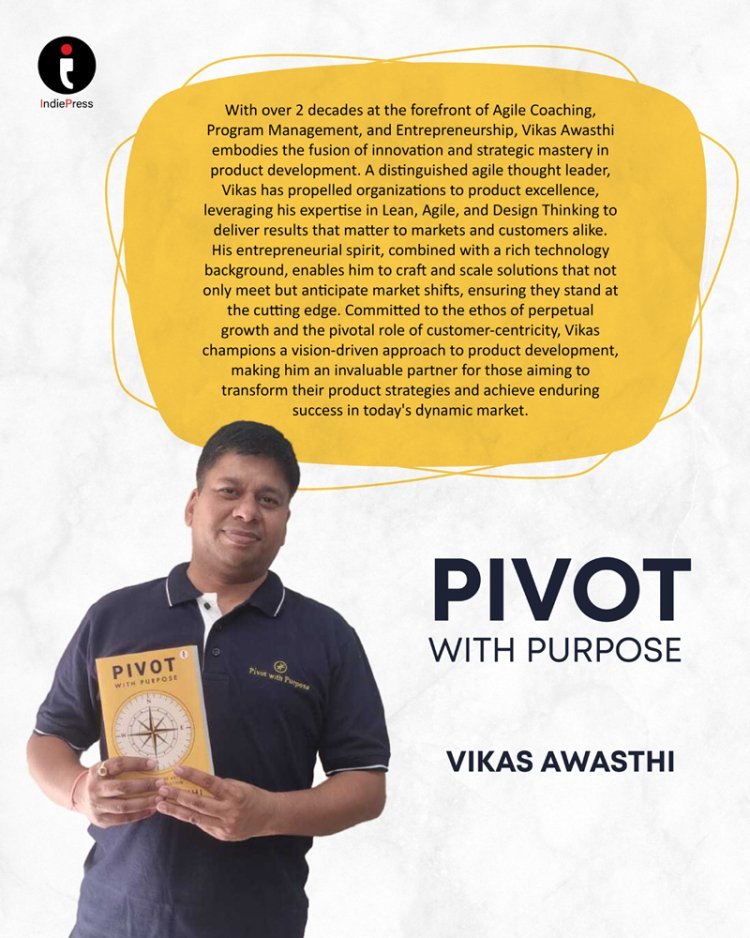Pivot with Purpose: Unlock the Secrets to Mastering Product Evolution by Author Vikas Awasthi
1. Could you give a brief synopsis of your book and the main issues it tackles in the modern world?
My book, Pivot with Purpose: Mastering the Art of Product Evolution, focuses on the complete product life cycle, offering actionable insights for organizations, business leaders, and product managers. In a rapidly evolving world where businesses face constant technological disruptions and shifting customer needs, navigating the product life cycle effectively is critical. The book provides strategies and frameworks that guide decision-making at every phase—from ideation and launch to maturity and decline. It helps readers manage product innovation, enhance customer satisfaction, and make informed strategic decisions, ensuring long-term success in an ever-changing market.
2. What specifically prompted you to write this book? What particular knowledge or experiences do you bring to the topic?
Over my two decades in the industry, working closely with organizations of all sizes, I noticed a recurring theme: many businesses struggled to navigate the full product life cycle effectively. While they were often excellent at launching new products, managing them through growth, maturity, and eventual decline posed a significant challenge. My experience in Agile coaching, product management, and technology leadership, combined with my entrepreneurial journey, inspired me to write this book. I wanted to provide business leaders, product managers, and decision-makers with a clear framework for making the right strategic decisions at each stage of the product’s life cycle, ensuring sustained growth and innovation. My expertise in helping organizations transition from project-focused to product-driven thinking laid the foundation for this book.
3. Could you outline some of the most important lessons or revelations that readers should anticipate from your book?
One of the key takeaways is the importance of understanding the entire product life cycle and how each stage requires a different strategic approach. Readers will learn how to identify the right time to pivot, scale, or sunset a product. The book emphasizes customer-centricity and the need to stay agile in decision-making. Another important insight is how cross-functional collaboration—between leadership, development teams, and marketing—can drive better outcomes. Whether you’re looking to optimize your existing product portfolio or launch a new one, the book provides a roadmap for aligning product strategy with long-term business goals.
4. Could you provide specific case studies or real-world examples from your book that exemplify the concepts you cover?
In the book, I’ve included several case studies that demonstrate how organizations across different industries navigated the product life cycle. For example, one case study focuses on a technology company that struggled with its product portfolio during the maturity phase. By strategically shifting their focus on product innovation, supported by agile practices, they were able to revitalize growth and delay product decline. Another example discusses a startup that embraced customer-centricity and adaptive planning early in the product life cycle, allowing them to pivot effectively and achieve market success. These case studies illustrate how timely, well-informed decisions can shape the trajectory of a product’s journey.
5. When creating this book, did you face any special difficulties or barriers? If so, how did you get beyond them?
One of the key challenges I faced while writing the book was distilling a wealth of experience and concepts into a format that is actionable yet accessible to a broad audience. The complexity of product life cycles can vary greatly across industries and businesses. My goal was to create a framework that could apply to different scenarios while remaining practical.
Another significant challenge was balancing my full-time professional commitments with the dedication required to write this book. What helped me the most was establishing a daily routine that allowed for focused, uninterrupted time to write. As an early riser, I began my mornings at 4:30 AM, utilizing those quiet hours to focus solely on writing. This time, before the demands of the day kicked in, became invaluable in helping me channel my energy and creativity into the authoring process. The early morning discipline allowed me to stay consistent and on track despite a busy schedule.
By focusing on one task at a time and setting clear priorities for each day, I was able to overcome the challenge of time management. I believe this structured routine was instrumental in completing the book while maintaining my other professional responsibilities.
6. What do you think readers will get out of your work, and how do you think it will improve their lives?
I hope readers come away with a comprehensive understanding of the product life cycle and the ability to make strategic decisions that lead to sustained growth and innovation. Whether it's a business leader making high-stakes decisions or a product manager working through daily challenges, the insights and frameworks presented in the book are designed to offer actionable guidance. I envision the book becoming a practical reference that readers turn to as they navigate different stages of their product journey, equipping them to drive success and avoid common pitfalls.
7. How does your book stay useful and flexible for readers over time in a world that changes so quickly?
In today’s fast-paced world, adaptability is key, and the principles outlined in the book are rooted in agile thinking, customer-centricity, and innovation — all of which remain relevant in dynamic environments. Rather than focusing on specific tools or methodologies that may become obsolete, the book emphasizes strategic decision-making and the need to constantly evaluate market trends, customer needs, and internal capabilities. This adaptability ensures that readers can apply the lessons from the book even as their industries evolve. Additionally, by fostering a mindset of continuous improvement, the book helps readers stay agile and responsive to future changes.
- buy your copy today and become a visionary product leader!

 brandmakerrd@gmail.com
brandmakerrd@gmail.com 

















